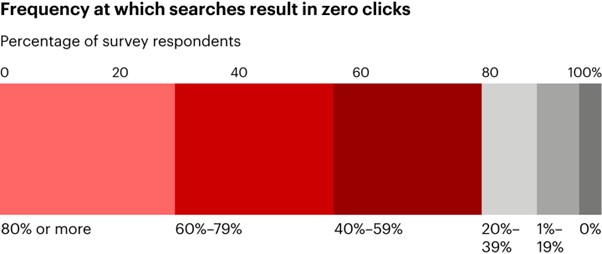
If you are a marketing practitioner these days, you will sympathize with the phenomenon that users are exposed to search results but do not lead to clicks, and users leave quickly even when clicks occur. Recently, AI-based summary information has become the center of the search environment, allowing users to get the information they need without having to visit a site. The so-called "zero-click" phenomenon has begun in earnest. Now, it is difficult to produce results only by the influx of searches. It is an era where "how many users came in and how much the users reacted and shifted" is more important than "how many users came in." Marketing strategies are also naturally changing from "inflow-oriented" to "flow-design-oriented" that creates a transition. In this article, we will look at how the zero-click phenomenon affects marketing, why the CTA is not clicked, and how to design a structure that drives the transition.
Why don't customers click? 🤔

(Source=Bain & Company)
In February 2025, a Bain & Company report found that around 80 percent of consumers rely on AI-based summary results when searching, and more than 40 percent of them do not move separate pages. In other words, they only get information from search results and solve problems. As we enter the era of "zero-click" searches, searches are no longer functioning as a means of navigating information but as a response system to get immediate answers. These changes also have the following implications for marketing strategies.
① Reduce search inflows
More users solve their questions only with search results → Lower overall inflow traffic and lower SEO performance
② Reduce opportunities for content exposure
Consume only necessary information from AI summaries without visiting sites → Reduce exposure to content such as brand stories, reviews, and product information
③ Highlight the importance of experience after a visit
Inflowed users do not leave or respond in a short time → CTA, recommendation, flow design-focused transition strategy required
CTA is one of the most affected factors in this change. The reason why customers don't click may not be because of the phrase.
3 Persuasion Formulas to Move Customers 🗒️
The reason why the CTA doesn't click is mostly because of the button statement, but because the customer hasn't been persuaded enough in front of it. For the CTA to work, three key elements must be naturally incorporated in front of it.
① CONNECTION OF INTEREST: What kind of issues or needs does the customer have now?
② Reason for induction of action: Why should I click CTA now?
③ Reward expectations: What benefits do I get if I click?
Without these factors, the customer has no clear reason to act. For example, if there is a 'get started now' button, the customer's interests, persuasion points, and expectations must be naturally linked to the previous content to lead to clicks.
The Power of Repeated Exposure 💪
The customer sees the CTA once and doesn't click right away. Rather, the more you encounter it in a familiar location, the more likely you are to click. For example, repeated CTAs in the middle of product details pages, the phrase "Start experiencing free" at the beginning and end of a blog post, etc. CTAs that are exposed repeatedly in these predictable locations provide not only click opportunities but also psychological stability. Even CTAs that were initially passed on will stop the second time and click the third time more often than expected.
Recently, automation tools that deploy CTA differently depending on customer conditions are also attracting attention. This is because the ability to automatically adjust the location, content, and exposure method of CTA according to customer segments, content conditions, and behavioral data is effective in improving the actual conversion rate. For example, Platier's Groobe is being used as a structural design tool to reduce the effort of practitioners and increase the conversion rate through automatic insertion of CTA by customer segment, fixed exposure of GNB, and CTA branch function based on content conditions.
👉 Worried about CTAs every time? Go to groobee
The marketing of the era of the era of "Moon-gu" is now not competition.Customers simply don't move to one button.To create a natural flow, context recommendations, context recommendations, context must be structurally designed to create a whole customer needs to be structurally designed.Now it's not changing one button, but it's time to design the entire path to click.Right, it's a real strategy to create transition in Zero-click.
Did you like today's content?
Subscribe to our PLATEER newsletter!
I will quickly send you the content selected by PLATEER via email.

Subscribe to our newsletter